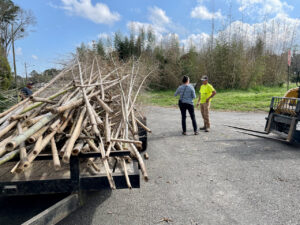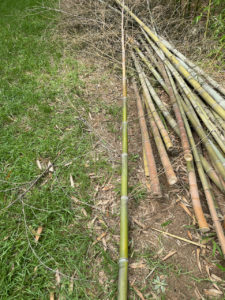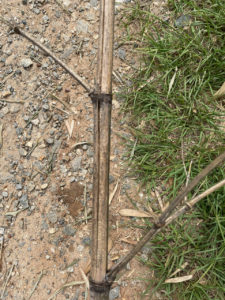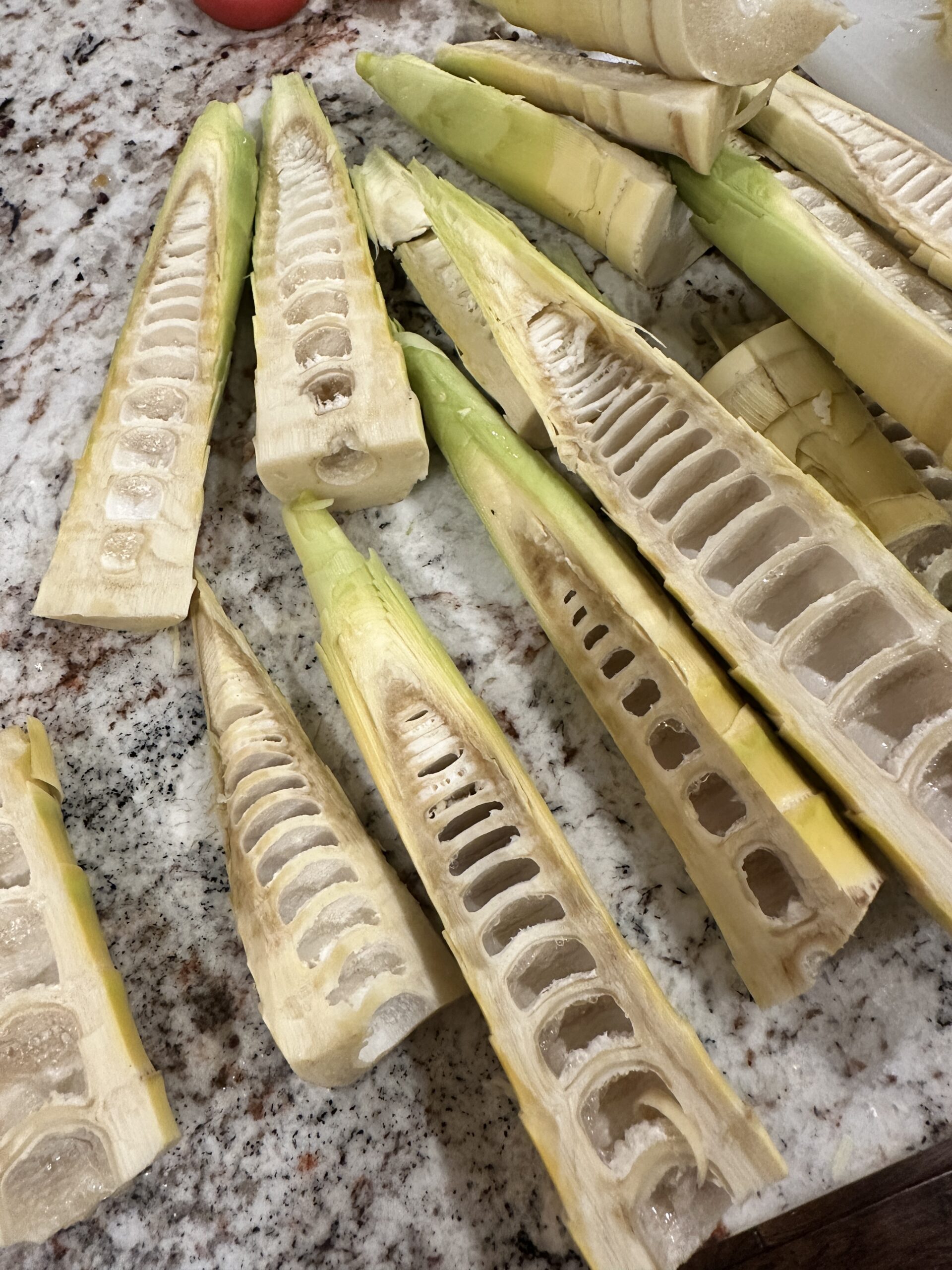Bamboo Fungus Disease
A common disease in parts of the Southeastern States kills bamboo.
 The historic Japanese timber grove at the Coastal Botanic Gardens in Savannah has died far back. Photo (Sept 2022) shows piles of dead grey poles and even more standing in place. The grove once was magnificent. It towered over visitors since at least the 1890s.
The historic Japanese timber grove at the Coastal Botanic Gardens in Savannah has died far back. Photo (Sept 2022) shows piles of dead grey poles and even more standing in place. The grove once was magnificent. It towered over visitors since at least the 1890s.
A vivax grove shading a cow pasture east of Hawkinsville GA died back in the same way. Similar but less extensive dieback occurs each year at the Old Silverbrook Cemetary in Anderson, South Carolina.
My bamboo farm in Hawkinsville GA has the same disease. The disease clogs the vascular system of the plant and so it can not carry enough water to the leaves. On a hot day, when the sun hits the upper leaves, the leaves curl up. Instead of uncurling during the night, they stay curled and die. The skin on the branches turns yellow. Branch by branch, the death moves down the cane. Lower branches are green and healthy until the disease moves down. If I cut the cane early, I can see the diseased part contrasting to the unaffected lower branches. If I cut the cane after death, the cane is grey like driftwood and often it has cracked open. Often the upper branches are blackened with spores.
At my farm, the disease has infected moso, meyeri, tanake, bambusoides, vivax, praecox, and dulcis, but not henon, houzeau, shanghai #3, the nine dwarf bamboos. In 2021 a pathologist from the County Extension Service came to take a look. I never heard back from her. In 2024, I sent small live plants to a plant pathologist at USDA-APHIS-Plant Germplasm Quarantine Program. They are growing them out in pots in the quarantine greenhouse to begin diagnosing the pathogen.
How I Combat the Disease.
Remove all dead and sick canes. We work with at least two people. One cuts; th other pulls the cut cane to the pile. The puller also “spots” the cane. Cutter inside the grove shakes cane. “Is this the one?” Spotter/puller, who is standing outside the grove with a view of the tops of the bamboo, “Yes, that is it”, or, “Go to your right and shake it”.
Kill the infected rhizome. The fungus resides in the rhizomes. Usually if an area has one dead cane, it has more. The rhizome in that area can only send up sick canes so those from that rhizome are along its path.
I have small tufts of bamboo here and there in the groves from where we cut shoots or poles. Some of these tufts are green and healthy. Others have yellow leaves with brown lines in some of the veins. I spot spray these leaves to kill that rhizome. I spray RoundUp on these yellow tufts. “RoundUp is the only herbicide that kills the roots”, says Dr. Mark Czarnota PhD, University of Georgia Department of Georgia.
From 2021 to 2024, we spent hours cutting dying and dead poles from seven of my twelve groves. We chip the poles. Because of the virus in the poles, I do not spread the chips in the groves. I use the chips on flower gardens and to smother a lawn to create a pollenator garden instead.
How I increase the health of the grove.
I spread a lot of mulch! I hope that with plentiful organic amendments, my bamboo will outgrow the pathogen. (The bamboo eats the mulch fast such that the feeding roots surface and more mulch is needed.) For a time, I spread llama poop from my neighbor every week. When I had steers, they pulled the sled and I spread cow manure and spoiled hay. The easiest mulch to spread was the hardwood sawdust. The hardest to spread was my neighbor’s spoiled round bales of hay. I’d prefer to spread bamboo chips but can’t because they are infected with the disease.
In 2023 I ordered $1000 worth of baled straw and spread it on all alleys. In 2024 my goats spread goat manure and soiled bedding every third day. I collected bagged leaves from urban neighborhoods whenever I went to the largest nearby city. I filled the mini van from the front seats to the rear and to the ceiling.
I spread (tree) logs in Row 1 of each grove. As logs rot, the microbes they support greatly increase the size and quantity of new canes of bamboo. Tobaris Holmes of Southbound Bamboo has demonstrated the miracle of rotten logs.
In 2025, a landscaper will bring trailer loads of tree chips to dump as piles in the dulcis and praecox. The dulcis grove is 2/3 killed off by disease. There is room to dump many loads of tree chips.
I irrigate hot days when we haven’t had rain.
Twice, I have spread many pounds of powdered sulfur on the groves. Recently in desperation I bought bags of 10-10-10 fertilizer from a farm supply store and spread it on my moso.
Symptoms
When standing outside the grove and looking up, you see above the canopy some canes that have no leaves. The branches and canes look dark. When you go into the grove and cut the pole and pull it from the grove, you may see that the top branches and culm have lost all green. The leaves are dead and gone. The skin died and is grey. Below them, lower branches still have leaves and the skin of the branches and culm are still green. More advanced disease symptoms are that all leaves on all branches have died and the culm is discolored with streaking brown lines showing vascular death. The skin dies with streaks and blotches. By the time the disease has finished, all the moisture is pulled out. The cane is so dry that
canopy some canes that have no leaves. The branches and canes look dark. When you go into the grove and cut the pole and pull it from the grove, you may see that the top branches and culm have lost all green. The leaves are dead and gone. The skin died and is grey. Below them, lower branches still have leaves and the skin of the branches and culm are still green. More advanced disease symptoms are that all leaves on all branches have died and the culm is discolored with streaking brown lines showing vascular death. The skin dies with streaks and blotches. By the time the disease has finished, all the moisture is pulled out. The cane is so dry that  it rattles when you pull it out of the grove. It is grey. It has what looks like black soot at joints and even covering some of the internodes. Before long, the upper cane cracks open.
it rattles when you pull it out of the grove. It is grey. It has what looks like black soot at joints and even covering some of the internodes. Before long, the upper cane cracks open.
In early March 2023 I sent a box of Phyllostachys praecox to a customer in Minnesota. The shoots arrived in 3 days and were discolored in the veins. I cut two shoots the next week to check them for disease. There is greening in the veins and the butts are not pure smooth white. I will not sell shoots from praecox this year.
